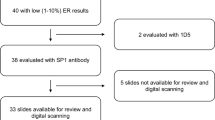Abstract
We have examined two new oestrogen receptor (ER) assays--an enzyme immunoassay (EIA) and an immunocytochemical assay (ICA) in a large series of primary breast tumours to compare their potential as predictors of (1) response to endocrine therapy and (2) survival in patients developing advanced breast cancer. Response to endocrine therapy was categorised at 6 months (UICC criteria). ER-ICA appears the better predictor of response to endocrine therapy than ER-EIA. Combining ICA and EIA results did not improve the prediction of response. With both assays patients with ER positive tumours survived longer from the time of diagnosis of advanced disease than those with ER negative tumours. The predictive power of these assay for progression of disease appears slightly better for the ER-ICA.
This is a preview of subscription content, access via your institution
Access options
Subscribe to this journal
Receive 24 print issues and online access
$259.00 per year
only $10.79 per issue
Buy this article
- Purchase on Springer Link
- Instant access to full article PDF
Prices may be subject to local taxes which are calculated during checkout
Similar content being viewed by others
Author information
Authors and Affiliations
Rights and permissions
About this article
Cite this article
Robertson, J., Bates, K., Pearson, D. et al. Comparison of two oestrogen receptor assays in the prediction of the clinical course of patients with advanced breast cancer. Br J Cancer 65, 727–730 (1992). https://doi.org/10.1038/bjc.1992.153
Issue Date:
DOI: https://doi.org/10.1038/bjc.1992.153
This article is cited by
-
Only estrogen receptor “positive” is not enough to predict the prognosis of breast cancer
Breast Cancer Research and Treatment (2018)
-
"Resurrection of clinical efficacy" after resistance to endocrine therapy in metastatic breast cancer
World Journal of Surgical Oncology (2006)
-
Predicting aggressive outcome in T1N0M0 breast cancer
British Journal of Cancer (2004)
-
Significance of immunohistochemical assessment of steroid hormone receptor status for breast cancer patients
Breast Cancer (2003)
-
Organochlorine exposures influence on breast cancer risk and survival according to estrogen receptor status: a Danish cohort-nested case-control study
BMC Cancer (2001)



